Abstract
In recent years, construction engineering technology has been developing rapidly, and the application of curtain walls inside modern buildings is also increasing. However, with the increasing number of curtain wall orders, most factories are facing challenges in the market due to low productivity caused by a low balance rate of curtain wall production lines. This paper is useful in improving the balance rate of the curtain wall production line; firstly, we use the improved genetic algorithm to obtain the optimal sequencing scheme of the curtain wall production line. Then, the optimization plan is validated through FLEXSIM simulation, and the results show that the device utilization rate of each workstation reaches 80%. Finally, this paper designs an intelligent production factory for curtain walls, and then builds an intelligent production line for curtain wall columns for experiments. The experimental results show that the workstation operation time has been reduced from 360 s to 300 s; the production line balance rate has increased from 57.04% to 91.60%. Therefore, it can be concluded that the modified genetic algorithm is valid in improving the balance rate of curtain wall production lines and raising the production efficiency of enterprises.
Keywords:
improved genetic algorithms; production line balance rate; Flexsim; intelligent production factory MSC:
37M05
1. Introduction
Building curtain wall refers to the enclosure of non load-bearing exterior walls of building objects, which is divided into two parts: panel and support structure. The panel is usually made of materials such as metal, glass, ceramics, and stone slabs, while the internal support structure adopts structural forms such as glass ribs, steel structures, and aluminum beams and columns, which mainly play a role in protecting and beautifying the exterior walls of buildings. The birth of curtain wall technology is a milestone in the technological development of the construction industry. With the development of the construction industry, the demand for curtain walls is rapidly increasing [1]. One of the key issues in curtain wall production is the balance of production lines. Currently, most curtain wall enterprises have low production line balance rates due to the many bottleneck workstations and low level of intelligence in their factory production lines.
The production of curtain walls is a comprehensive processing process. From feeding to finished products, curtain wall products need to go through a series of processes such as processing and assembly [2]. The general process of curtain wall production includes the following steps. Step 1 is the preliminary preparation work: preparing production task books, editing processing processes, reviewing process documents, formulating production plans, arranging production, and receiving materials. Step 2 is machining: cutting according to the assembly sequence of the unit baffle. The cutting process includes sawing, end milling, milling, drilling, etc. Step 3 is the assembly, including the installation of components, assembly of frames, installation of glass, and the injection of structural adhesive. Step 4 is cleaning and maintenance, carrying out an inspection and storing after passing the inspection [3]. Due to the unique nature of the curtain wall structure, there is a significant difference in the operating time of each processing process, which leads to the emergence of bottleneck workstations. Due to the varying levels of skill proficiency among workers, there is no unified standard for the operation time of each process, resulting in a low level of intelligence in the production line. Both have led to a low balance rate in the curtain wall production line.
The optimization method for curtain wall production lines still relies on the personal experience of production technicians, and this method often does not improve the balance rate of the production line much, making it difficult to achieve the maximum production capacity of the production line [4,5]. Therefore, it is necessary to seek a scientific and effective method to optimize the curtain wall production line. The balance problem of curtain wall production lines is a type of assembly line balance problem (ALBP). In the past decade, assembly line balance problems have been studied by many scholars, involving mathematical methods, heuristic rules, and intelligent algorithms. Genetic algorithm, as an efficient modern method, has been successfully applied to solve production line balance problems. However, traditional genetic algorithms have the disadvantages of limited search space and they easily fall into local optima [6,7]. Multi population genetic algorithms operate in multiple populations using specific methods. Multi population genetic algorithms are both relatively simple and easy to implement and, because they expand the search space, they have the characteristic of being able to jump out of local optima. This paper proposes using a dual population genetic algorithm to solve the Type-2 balance problem of curtain wall production lines.
1.1. The Objective of the Paper
- To build a mathematical model for Type-2 balancing of curtain wall production lines and mathematical evaluation indexes;
- To propose an improved genetic algorithm to solve the mathematical model for Type-2 balancing of curtain wall production lines;
- To compare the optimization plan for different numbers of workstations and obtain the best solution;
- To design an intelligent production factory for curtain walls and build an intelligent production line for curtain wall columns for experiments to verify the feasibility of improving genetic algorithms.
1.2. Paper Organization
The remaining parts of this article are as follows. Section 2 contains the literature review of this paper. Section 3 builds the mathematical model for balancing curtain wall production lines and its mathematical evaluation indicators. Section 4 proposes an improved genetic algorithm. Section 5 compares the optimization plan for different numbers of workstations. Section 6 verifies the feasibility of the optimal solution by FLEXSIM simulation, then designs an intelligent production factory for curtain walls and builds an intelligent production line for curtain wall columns for experiments. Section 7 concludes the results of the paper and future work.
2. Literature Review
Assembly line balancing plays a major role in assembly process programming in the auto industry. The assembly line balancing issue is an NP-hard issue, particularly for the double-sided assembly line balancing issue. Yin Qidong et al. [8] presented a heuristic algorithm for dealing with the balancing issue of a double-sided assembly line; using a mathematical model based on the balancing problem of a double-sided assembly lines, they analyzed the characteristics of the issue. They implemented numerical experiments based on the benchmark data sets. The results validate the validity and efficiency of the presented algorithm.
El Ahmadi et al. [9] proposed a new model adaptable to the automotive sector, based on the mathematical model previously developed by the E-type SALBP problem. The presented model employs new feasibility rules and optimization constraints to present better equilibrium results and efficiency. The experimental findings show that the presented model enhances the efficiency of the line by 15%, which proves the good robustness of the presented approach.
Type-1 simple assembly-line balancing problems (SALBP-1) mean minimizing the number of workstations by holding cycle times constant. Baskar, A. et al. [10] proposed a new heuristic approach for solving simple Type-1 assembly line balancing problems and analyse them using a number of benchmark questions from the documentary. They used the slope index to rank jobs and assign them to different workstations. Zhang, Han-ye [11] purposed an immune genetic algorithm (IGA) to solve the SALBP-1. He proposed user-defined constructor called psi(center dot) to convert all individuals during the IGA run to meet the requirements of the priority relationship. The computational experimental results show that the presented approach is an efficient one.
For the less-studied issue of balancing a multi-constraint two-sided mixed-mode assembly line, Luo Yuwei et al. [12] constructed a multi-objective double-sided hybrid assembly line equilibrium mathematical model. This model takes the minimal number of stations to be paired. Taking into account partition constraints and collaborative operation constraints, the goal is to achieve a maximum assembly line balance rate and minimum smoothness index. The model was solved by an improved genetic algorithm, which uses a sequence combination based coding method with improved initialization of populations, decoding, etc.
Zamzam, N et al. [13] proposed the issues of balancing a bi-objective time and space multi-manned assembly line. In addition to the conventional constraints on the assembly line, a hybrid genetic algorithm under temporal and spatial constraints was used to model the issue. The initial population generation was based on the traditional assembly line heuristic with the addition of stochastic generations. The aim of the model was to minimize the number of workers and the number of stations. The results showed that the presented model is very effective in solving the multi-carrier spatio-temporal pipeline issue.
Jiao, Yuling et al. [14] established the Type-E balance modelling for the U-shaped production line and solved it by using heuristic algorithms based on composite ranking values, obtaining E-balance problems for chassis model U-assembly line plans and planning line layouts. Comparing the results of the heuristic algorithm, genetic algorithm, and simulated annealing method with examples shows that the degree of load balancing is slightly higher than that of the genetic algorithm and the simulated annealing method.
The mixed programming models for nonlinear integers were built for a U-shaped assembly line for the composite optimization of multiple optimization objects by Wang, Ting et al. [15]. The modified genetic algorithm was used for optimization plans. After applying the model to Company X, the weighted average load balance and assembly line cadence of each station, as well as the time fluctuation of the stations, were improved, which verified the optimization of the model and the applicability of the modified genetic algorithm.
Rabia Musheer Aziz et al. [16] developed an advanced stage of learning model by using an individual metaheuristic optimization policy. The new optimization approach to conquering the gaps, the enhanced Genetic Algorithm-Cuckoo Search (GA-CS), was combined with advanced learning. A combined experiment was performed to evaluate the effectiveness and performance of the proposed policy in comparison with various popular techniques. The proposed technology and SVC model outperform other models and have the best accuracy rate; in contrast, deep learning with the suggested optimization policy outperforms the RF models with a marginally better result of 99.71% and 98.33%, respectively.
The design of hybrid active power filters (HAPFs) was a difficult task and therefore a meta-heuristic algorithm was used to handle this nonlinear optimization issue. Shoyab Ali et al. [17] proposed a novel hybrid metaheuristic algorithm (Marine Predator Algorithm and Sine Cosine Algorithm) for choosing the optimal parameters for HAPF. Different algorithms for obtaining HAPF parameters were also compared to display the proposed hybrid algorithm’s case efficacy. The results of the presented algorithm were solid and could be used as a possible tool for estimating the HAPF values.
3. Curtain Wall Production Line Balance Model Construction
3.1. Model Assumptions
- (1)
- The number of workstations in the production line shop, the operating time of each process, and the order in which the products will be processed are known.
- (2)
- The type and quantity of processing equipment required for the production line is known.
- (3)
- A machining process cannot be assigned to two workstations.
- (4)
- Workers on the production line operate at essentially the same level for each operational process, and each worker can skilfully complete any of the processes.
3.2. Constraints [18,19]
The constraints for the production line equilibrium modeling are as follows:
- (1)
- Process i should be completed at exactly one workstation.where i is the work process, , m is the workstation, , and J is the total number of workstations.
- (2)
- The operating time of each workstation does not exceed the production line beat.where is the set of operating time of the mth workstation and is the Takt Time of the production line.
- (3)
- Process Priority Constraints
The production of a product has a certain sequence of job elements determined by the production process. In the production sequence of operations, a job element is assigned when, and only when, all immediately preceding job elements of that job element have been assigned. The graphical representation of the prioritized relationships of the work processes is shown in Figure 1:
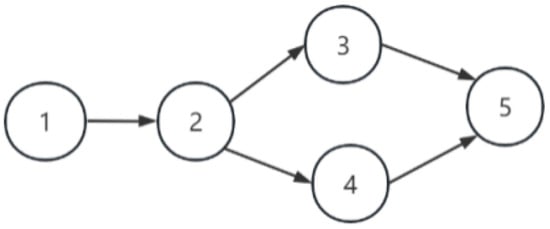
Figure 1.
Example of a prioritized relationship diagram.
The task association matrix represents the prioritization constraint relationship between n tasks with the following expression:
where indicates that i is a direct predecessor task of j, job task i must be assigned to the previous station where j is located during the assignment of job elements. indicates that i is not a direct predecessor task of j. If , then is the task prioritization association matrix, where x and y are both processing operations and n is the total number of processing operations.
3.3. Objective Function
We study the Type-2 production line balancing problem; the number of workstations m, the task time, and the preferred order are given, and the objective is to minimize the production line beat CT to obtain the maximum productivity, which has the following mathematical expression:
where is the maximum productivity, denotes the working hours of the ith station, indicates the maximum workstation time, m is the number of workstations, and is the Takt Time.
3.4. Mathematical Evaluation Indicators
- (1)
- The balance rate of the production line P is usually used to describe the degree of balance of the entire production line operating time; the expression is as follows:
- (2)
- Equilibrium Index SI: This is used to measure the degree of deviation between a particular workstation and the average production time of the entire production line, with the following expression:
4. Improved Genetic Algorithm Design
The genetic algorithm is an iteratively adaptive probabilistic quest approach that draws on the natural selection and natural mechanisms of inheritance in living organisms. Genetic algorithms are well suited to dealing with complexity and non-linear optimization problems that are hard to solve using conventional approaches [20]. In this paper, an improved genetic algorithm is proposed to solve the second type of equilibrium problem.
The traditional genetic algorithm basically uses an initial population to start the operation, crossover, and genetic mutations; this method is simple and easy to implement, but there are problems such as premature convergence. For this problem, a kind of multiple population genetic algorithm (MPGA) can be used to replace the standard genetic algorithm (SGA). In this paper, a dual population population genetic algorithm is used to solve the production line balance problem in the curtain wall production line. The general flow of the dual population genetic algorithm is indicated in Figure 2.
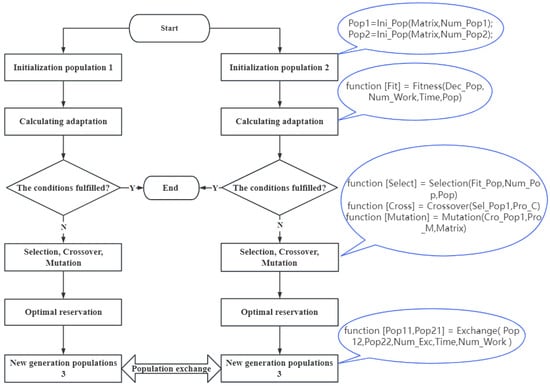
Figure 2.
Flowchart of the dual population genetic algorithm.
4.1. Coding
The coding of the genetic algorithm is divided into two steps: the first step is the numbering of the tasks or processes; the second step is the coding of the chromosomes. The optimal coding method is to code the processes according to the logical relationship; according to the logical sequence of the processes, the processes are arranged in a column and each process corresponds to a gene position. In this paper, the genetic coding is based on the priority relationship matrix of production operations, and the sequential coding of the operation number is used to obtain the initial bi-population chromosomes, which effectively ensures that each chromosome is a possible operation, greatly reduces the amount of computation, and speeds up the evolutionary process.
4.2. Decoding
Because the production beats of the production line Type-II balancing problem are unknown, it is not possible to allocate job elements at the production line beats at the time of decoding, and the general solution is to anticipate a beat and then perform trial calculations in certain increments. In a real production line, the increment of a beat is not a continuous value but is incremented by the time value of a job element. Based on this, the following was deisgned for the second type of production line balancing problem decoding:
- (1)
- Calculate the theoretical minimum production beat:where T is the sum of operation elements and m is the given workstation. Let .
- (2)
- Using as the production beat, assign n elements to m workstations according to the logical relationship of the job elements, and the time of each workstation is: . If the time of each workstation , then is the minimum beat under this ordering, and the search stops; otherwise, proceed to the next step.
- (3)
- Calculate the potential increments for the production line, where the value of is the time of the first job element at the st workstation, respectively.
- (4)
- Let and ; if , then is the minimum beat under this ordering and the search stops; otherwise return.
4.3. Adaptation and Selection
The fitness function is the criterion that distinguishes between good and bad individuals in a population and is the only basis for evolution. The objective of the second type of equilibrium problem of the production line is to minimize the production beats and to minimize the smoothing index. In this thesis, the fitness function consists of three parts and its expression is as follows:
where is for determining whether a process is on the specified station; if so, then .
In this paper, the roulette selection method is chosen, the probability of a chromosome being selected is set to be proportional to a function of its fitness, the size of the population is set to be n, and the fitness of an individual p is set to be ; then is the probability that the chromosome in an individual p can be successfully inherited by the next generation of the population, and its formula is as follows:
4.4. Crossing and Mutations
In this paper, the 2-point crossover method is used; two random crossover points are generated to produce the first crossover point. For a chromosome with n genes, a random integer at is generated to determine the first crossover point, ; after generating the first crossover point , the second crossover point is positioned behind the first crossover point position, and a random integer, , is generated between to determine the second crossover point. The two crossover points divide the entire chromosome into three parts: head, body, and tail. The crossover of the chromosome is performed on the body part among the two points.
In a chromosome, a random mutation point is generated and the gene fragments before the mutation point are retained throughout the zygote chromosome, while the gene fragments after the mutation point are recombined. This is carried out by deleting all the gene segments before the mutation point in the priority relationship table and then re-producing a viable gene segment according to the method of generating the initial solution; the combination of the deleted gene segment and the re-produced viable gene segment is the new chromosome.
4.5. Population Gene Exchange
The population gene exchange is divided into two steps: the first step is to find the two best adapted genes in the two populations and exchange them, and the second step is to randomly exchange the remaining genes from the two populations in the first step.
5. Implementation of the Algorithm
5.1. Data Preparation
This paper analyzes and optimizes the production line as an example of a curtain wall factory producing monolithic curtain walls.The production process of a unit curtain wall is shown in Figure 3, and the working time of each process is shown in Figure 4, from which it can be seen that the production process of a unit curtain wall consists of 23 processes, and the total processing time is 2310 s. According to the production line balance model, the balance rate of the curtain wall production line is calculated to be 57.04%.
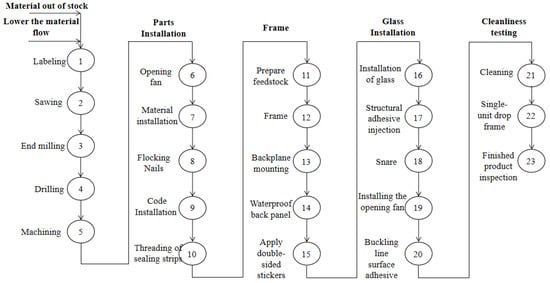
Figure 3.
Flow chart of unit curtain wall production.
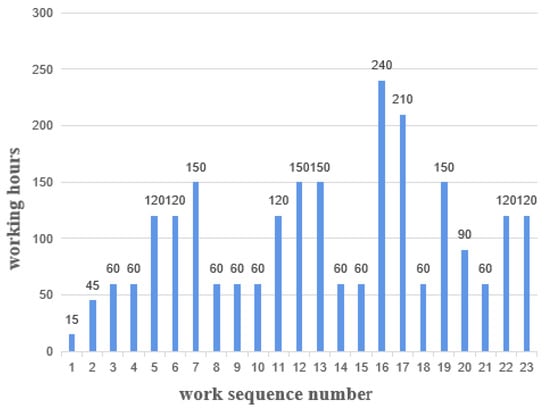
Figure 4.
Working time of each process.
5.2. Matlab-Based Implementation of Two-Population Genetic Algorithm
The number of initial population 1 and initial population 2 in the setup program are both 100; the crossover probabilities of initial populations 1 and 2 are set to 0.8 and 0.2, respectively; the mutation probabilities of initial populations 1 and 2 are set to 0.2 and 0.05, respectively; and the number of genetic generations is set to 250.
The optimization of the curtain wall production line is carried out by selecting the number of workstations , respectively, and the resulting program operation results in the balance rate and the balance index of the production line, which are calculated by the previous equations, as shown in Table 1.

Table 1.
Optimization results of genetic algorithm.
In order to compare the optimization scheme more clearly according to Table 1, the production line balancing rate and balanced index changes are shown in Figure 5. It can be seen in Figure 5 that, when the workstation , the production line balance rate is at its maximum and the equalization index is at its minimum, but the production beat is not at its minimum. Therefore, the optimal solution is when the workstation . The scheme diagram is shown in Figure 6.
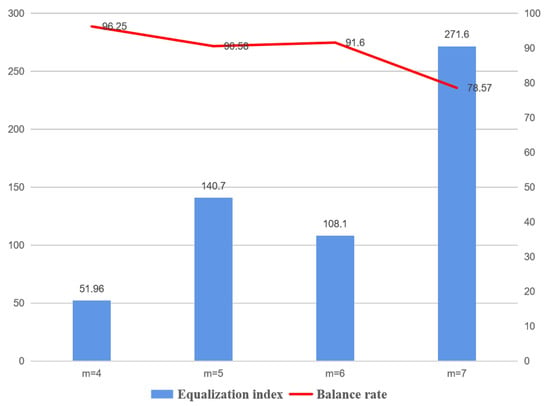
Figure 5.
Graph of equilibrium rate and equilibrium index.
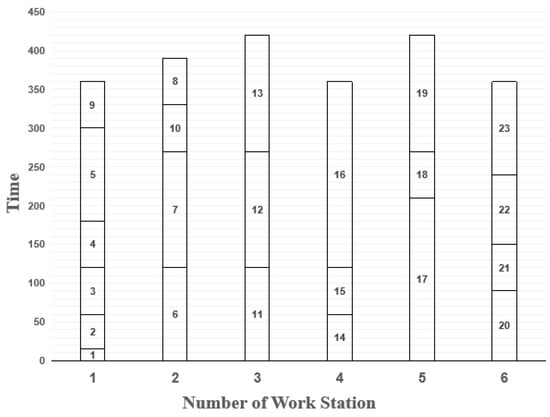
Figure 6.
Distribution of workstations.
6. Optimization Effect Evaluation
6.1. Simulation Results
In order to better verify the effect of dividing the workstations into six, the simulation model is built in Flexsim, where the workstations are handled with a composite processor and each workstation is assigned an operator, as shown in Figure 7. After setting the parameters, the simulation model is run; the results obtained from the run are shown in Table 2.
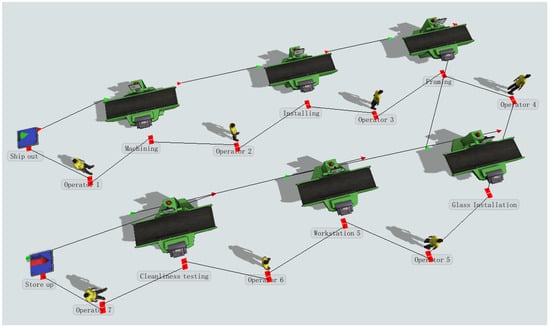
Figure 7.
Simulation model diagram.

Table 2.
Simulation results.
After dividing into six workstations, the occupancy rate of each workstation exceeded 80%, the utilization rate of the equipment was greatly improved, and the balance rate of the whole production line was increased from the original 57.04% to 91.6%.
6.2. Experimental Results
At the same time, in order to solve the problem of the low automation of the existing curtain wall factory, an intelligent curtain wall production factory was designed while the optimization results were applied to the designed intelligent curtain wall production factory. The smart factory is divided into three areas, namely, Area A (blue), the machine processing area, Area B (yellow), the warehouse and logistics distribution area, and Area C, the unit assembly area. In Zone A, an automated column production line is set up to complete the processing of aluminum profiles and the assembly of components. Area B transports raw materials for aluminum profiles from the warehouse to Area A and other raw materials to Area C via AGV. Area C is built with a truss manipulator, a six-degrees-of-freedom manipulator, and an intelligent glue injection unit to complete the work of framing, glass installation, glue injection, etc., as shown in Figure 8.
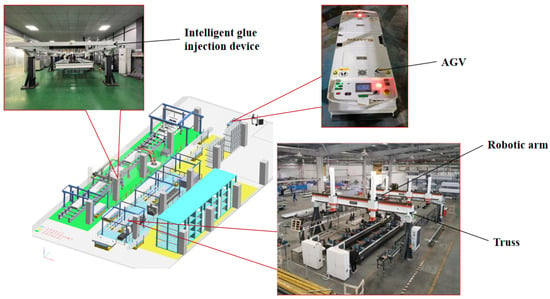
Figure 8.
Intelligent factory diagram.
The processes contained in Workstation 1 are applied to the intelligent column production line in Area A. The intelligent column production line mainly consists of five truss robotic arms, one truss wood picking robot, one AGV trolley, one roller conveyor line, one labeling machine, three control cabinets, and various machine tools. Five robotic arms can realize linear motion in the Z-axis direction and the Y-axis direction, controlled by Baoyuan CNC’s R6800 truss robot controller, while the motors and drives are selected from the Huichuan SV660N series and IS620N series; the automated column production line is shown in Figure 8. The automated column production line can complete the unloading work from process 1 to process 5, while process 9 is completed in the parts assembly area in Area A. The results after testing are shown in the data graph in Figure 9.

Figure 9.
Graph of operating time of each process before and after optimization.
As can be seen in Figure 9, the operating time of each process is obviously reduced after optimization, and the total operating time of Workstation 1 is reduced from 360 s to 300 s, which is a 16.66% reduction in working time; it improves the production efficiency and increases the production capacity of the enterprise.
7. Conclusions
This paper used an improved genetic algorithm to solve the Type-2 balance problem of curtain wall production lines. The optimization plan was simulated by using Flexsim, and the results showed that the device occupancy rate of each workstation reached 80%. At the same time, the optimization scheme was applied to the intelligent curtain wall production factory for experiments, and the experimental results showed that the CT was reduced to 420 s. The working time of Workstation 1 has been compressed to 300 s, and the production line balance rate has increased from 57.04% to 91.60%. Research has shown the effectiveness of improved genetic algorithms in improving the balance rate of curtain wall production lines as well as the practicality of intelligent curtain wall production factories, which improves production efficiency. Due to limitations in terms of conditions, this paper only focuses on a single variety of curtain wall as the research object, without studying whether the improved genetic algorithm is applicable to multi variety mixed flow production lines. Future research will be expanded to the balance research of multi variety mixed flow production lines, as well as to the development of a curtain wall production line balance optimization system linked to production management systems, to further improve enterprise production efficiency.
Author Contributions
Validation, J.W. and D.Z.; Data curation, G.Q.; Writing—review & editing, H.X.; Supervision, W.W.; Project administration, Z.X. and B.L. All authors have read and agreed to the published version of the manuscript.
Funding
This research was funded by the Education Department of Guangdong Province Project under grant 2021ZDZX1020 and the Special Funds for Cultivation of Science and Technology Innovation for Guangdong University Students PDJH2022A0404.
Data Availability Statement
The corresponding author will provide the data used in this work upon reasonable request.
Acknowledgments
The authors extend their appreciation to the Guangdong Provincial Government for funding this work via the Guangdong Provincial Department of Education Project under grant 2021ZDZX1020 and the Special Funds for Cultivation of Science and Technology Innovation for Guangdong University Students PDJH2022A0404.
Conflicts of Interest
The authors declare that they have no conflict of interest.
References
- Sun, Y.G. The Impact of High-rise Building Curtain Wall Technology in the Exploring Period (1895–1959). In Proceedings of the 2nd Annual International Conference on Advanced Material Engineering (AME 2016), Wuhan, China, 15–17 April 2016; Atlantis Press: Amsterdam, The Netherlands, 2016; pp. 1357–1361. [Google Scholar] [CrossRef]
- Chen, K.; Lu, W. Design for manufacture and assembly oriented design approach to a curtain wall system: A case study of a commercial building in Wuhan, China. Sustainability 2018, 10, 2211. [Google Scholar] [CrossRef]
- Lee, A.D.; Shepherd, P.; Evernden, M.C.; Metcalfe, D. Optimizing the architectural layouts and technical specifications of curtain walls to minimize use of aluminium. Structures 2018, 13, 8–25. [Google Scholar] [CrossRef]
- Jiang, L.; Duan, J.J.; Zheng, R.; Shen, H.; Li, H.; Xu, J. Optimizatiob and Simulation of Garment Productiob Line Balance Based on Improver GA. Int. J. Simul. Model. (IJSIMM) 2023, 22, 303–314. [Google Scholar] [CrossRef]
- Boysen, N.; Schulze, P.; Scholl, A. Assembly line balancing: What happened in the last fifteen years? Eur. J. Oper. Res. 2022, 301, 797–814. [Google Scholar] [CrossRef]
- Zhang, P.; Dong, Y. Strategy transformation of big data green supply chain by using improved genetic optimization algorithm. Soft Comput. 2023, 1–10. [Google Scholar] [CrossRef]
- Niu, H.; Hou, T.; Chen, Y. Research on Energy-saving Operation of High-speed Trains Based on Improved Genetic Algorithm. J. Appl. Sci. Eng. 2022, 26, 663–673. [Google Scholar] [CrossRef]
- Yin, Q.; Luo, X.; Sun, J.; Zhang, L. A Workstation Solution Based Heuristic Algorithm for Assembly Line Balancing Problem. In Proceedings of the 2021 33rd Chinese Control and Decision Conference (CCDC), Kunming, China, 22–24 May 2021; pp. 4010–4015. [Google Scholar] [CrossRef]
- El Ahmadi, S.E.A.; El Abbadi, L.; Elrhanimi, S. Efficiency Improveement of Automotive Assembly Lines Using Simple Assembly Line Balancing Problem Type-E. LogForum 2023, 19. [Google Scholar] [CrossRef]
- Baskar, A.; Anthony Xavior, M.; Nithyanandan, N.; Dhanasakkaravarthi, B. Analysis of a Few Heuristics Proposed Based on Slope Indices to Solve Simple Type—I Assembly-Line Balancing Problems. In Advances in Simulation, Product Design and Development: Proceedings of AIMTDR 2018; Springer: Singapore, 2019; pp. 499–506. [Google Scholar] [CrossRef]
- Zhang, H. An immune genetic algorithm for simple assembly line balancing problem of type 1. Assem. Autom. 2019, 39, 113–123. [Google Scholar] [CrossRef]
- Luo, Y.; Chang, J.; Zhang, F.; Zhang, S. A Research of Multi-Constrained Two-sided Mixed-model Assembly Line Balancing Problem Based on Genetic Algorithm. In Proceedings of the 2020 IEEE 7th International Conference on Industrial Engineering and Applications (ICIEA), Bangkok, Thailand, 16–21 April 2020; pp. 377–381. [Google Scholar] [CrossRef]
- Zamzam, N.; Elakkad, A. Time and space multi-manned assembly line balancing problem using genetic algorithm. J. Ind. Eng. Manag. (JIEM) 2021, 14, 733–749. [Google Scholar] [CrossRef]
- Jiao, Y.; Cao, N.; Li, J.; Li, L.; Deng, X. Balancing a U-Shaped Assembly Line with a Heuristic Algorithm Based on a Comprehensive Rank Value. Sustainability 2022, 14, 775. [Google Scholar] [CrossRef]
- Wang, T.; Fan, R.; Peng, Y.; Wang, X. Optimization on mixed-flow assembly u-line balancing problem. Clust. Comput. 2019, 22, 8249–8257. [Google Scholar] [CrossRef]
- Aziz, R.M.; Mahto, R.; Goel, K.; Das, A.; Kumar, P.; Saxena, A. Modified genetic algorithm with deep learning for fraud transactions of ethereum smart contract. Appl. Sci. 2023, 13, 697. [Google Scholar] [CrossRef]
- Ali, S.; Bhargava, A.; Saxena, A.; Kumar, P. A Hybrid Marine Predator Sine Cosine Algorithm for Parameter Selection of Hybrid Active Power Filter. Mathematics 2023, 11, 598. [Google Scholar] [CrossRef]
- Belkharroubi, L.; Yahyaoui, K. Solving the mixed-model assembly line balancing problem Type-I using a Hybrid Reactive GRASP. Prod. Manuf. Res. 2022, 10, 108–131. [Google Scholar] [CrossRef]
- Yadav, A.; Agrawal, S. Mathematical model for robotic two-sided assembly line balancing problem with zoning constraints. Int. J. Syst. Assur. Eng. Manag. 2022, 13, 395–408. [Google Scholar] [CrossRef]
- Anwaar, A.; Ashraf, A.; Bangyal, W.H.K.; Iqbal, M. Genetic Algorithms: Brief review on Genetic Algorithms for Global Optimization Problems. In Proceedings of the 2022 Human-Centered Cognitive Systems (HCCS), Shanghai, China, 17–18 December 2022; pp. 1–6. [Google Scholar] [CrossRef]
Disclaimer/Publisher’s Note: The statements, opinions and data contained in all publications are solely those of the individual author(s) and contributor(s) and not of MDPI and/or the editor(s). MDPI and/or the editor(s) disclaim responsibility for any injury to people or property resulting from any ideas, methods, instructions or products referred to in the content. |
© 2023 by the authors. Licensee MDPI, Basel, Switzerland. This article is an open access article distributed under the terms and conditions of the Creative Commons Attribution (CC BY) license (https://creativecommons.org/licenses/by/4.0/).